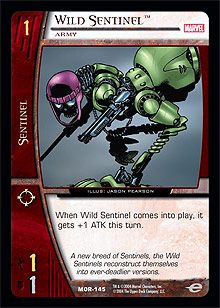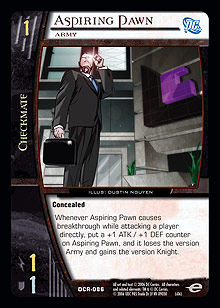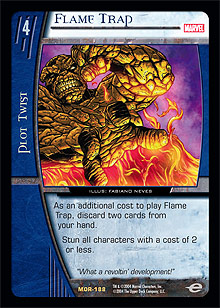
When I sat down to write this article, I had a firm concept in my mind that I wanted to put into paper (or digital paper, if you will). However, sometimes things are easier than they seem, you know? I had received an email from a wonderful individual a couple of weeks ago who asked me to write about the basics of deck construction. I have already written about constructing a normal curve deck, and now I am back with the second exciting installment: off-curve craziness!
So what does off-curve craziness entail? No, it doesn’t have anything to do with Tim Batow, though this would be an appropriate spot for a short joke. My friend, teammate, and fellow Metagame.com writer, Jeremy Blair, urged me to curtail the short jokes. I know, I know. I tried to appeal to him and say that it wasn’t to make me laugh, but to make you, my loyal readers, chuckle. But he wouldn’t budge, so I will make a real concerted effort to stop my short jokes!
With short jokes out the window, what amusing anecdote can I open with? How about crazy cow-riding exploits? I know that is a little random, but this is my last story from Pro Circuit San Francisco, and I want to be sure to get it out. The setting was the Hard Rock Cafe in San Francisco. John Hall, Mike Barnes, Josh Wiitanen, Tim Batow, and I were celebrating Tim’s 5th place finish and me making it through coverage of two Ivy League matches (much more exhausting than you may think). As we walk in, we see pretty much what you would expect to see at a Hard Rock Cafe: the souvenir shop, a whole bunch of music and movie memorabilia, and a cow. Wait—did I just say “cow”? Yes, I did. There was a life-sized ceramic cow right by the entrance into the restaurant. When he saw this, John Hall started prodding me to get on it so he could take a picture. He said it would be a better picture than the one they use for me at Metagame.com. You can feel the love there, can’t you? Anyway, I took one look and knew that hollow cow could not handle my not-so-hollow frame. Then we had a great idea—what if Tim got on it? After much pushing, he finally got on and did a myriad of poses (including a handstand). Needless to say, it was pretty funny.

Usually, this is where I tie in my previous story by some shoestring to make it all flow. To be perfectly honest, there isn’t any connection. That story was just too funny for me not to include. Hopefully, seeing the picture above will help you understand just how funny it really was.
OFF-CURVE?
What in the world could this article do to help you, an aspiring Pro Circuit competitor? Well, it depends. This article’s goal isn’t to give you a deck to play at Pro Circuit Indy or even the next $10K. This article is really designed to help you at the very basic level: deck construction.
We’ll start by looking at Silver Age. Faces of Evil was mostly nonexistent at Pro Circuit San Francisco; Ivy League totally crushed it. Granted, there were still some brave souls who stood fast and took what they knew or what they liked, but they were definitely outnumbered and, for the most part, outgunned.
But with Ivy League going away, perhaps off-curve is being given a second chance. This is why I am writing this article. I believe it is possible for a good player to take an off-curve deck to a Top 8 finish at $10K Charlotte. By the time you read this, the event will be over, so you will know whether or not I was right. What follows should serve as a helpful guide when trying to develop and build an off-curve deck.
SKELETON KEY?
My fiance and I just finished watching this movie the other day. Let me tell you—when they tell you if you don’t believe in voodoo, it can’t hurt you, they don’t know what they are talking about. Needless to say, you won’t be seeing me anywhere near any voodoo charms, unless of course you are talking about Brother Voodoo.
Anyway, we need to set up a skeleton to work from. Below is what I would envision as a standard off-curve setup:
1-drops: 10-15
2-drops: 10-15
3-drops: 4-8
This gives us a standard curve resulting anywhere from 24 characters (a nut low) to 38 characters (a nut high). I wouldn’t recommend either extreme as a good way to go about building a deck, but the above list should help you determine where the drops should be.
By essentially evening out the 1- and 2-drops, you increase your chances of hitting both a 1- and 2-drop in your opening hand—a quality hand to keep in an off-curve deck with all else equal.
NUMBER 1, BABY!!!
I know you immediately thought of Dick Vitale. I know I did! Anyway, you have to start with your 1-drops. It all begins and ends there. These characters allow you to be aggressive from the get-go and also give you many options for underdropping.
 Generally, characters that can give you a 2 ATK body on turn 1 are a good way to go. They are aggressive, and if lucky, can take down a 2-drop by themselves. If you play a character that has a 1 ATK, it would be a good rule of thumb to make sure that the ability he or she provides is worthwhile (e.g., Yellowjacket).
Generally, characters that can give you a 2 ATK body on turn 1 are a good way to go. They are aggressive, and if lucky, can take down a 2-drop by themselves. If you play a character that has a 1 ATK, it would be a good rule of thumb to make sure that the ability he or she provides is worthwhile (e.g., Yellowjacket).
What’s interesting is that there are some decks that are built entirely on 1-drops. The Anti-Green Lantern deck is a good example. If you really want to stretch it, you could go back to the heyday of “Wild Vomit” (Longshot + Wild Sentinel + Sentinel Mark IV). However you cut it, there have been a couple very successful decks that play around 20-30 1-drops. I say that should command a little attention.
This doesn’t mean that you should max out your 1-drops or anything drastic like that, but it does go to show that the more you play, the easier the mulligan condition becomes. If you are just looking for a hand with a specific 2-drop and any 1-drop, the more 1-drop characters you play, the better position you will be in to hit your mulligan. Make sense? I hope so.
Here are some 1-drops that you may want to consider when trying to build a deck for the upcoming DC Modern Age:
- Count Vertigo—He may seem a little bit odd to include here, but in a format with very little stall, seeing this guy every other turn can be REALLY annoying. Combine him with Talia, Daughter of Madness, and that’s a pretty good exhausting technique. Oh, and it doesn’t target either, so it gets around that nasty Cloak of Nabu.
- Ted Kord ◊ Blue Beetle—I don’t think he needs any introduction, but even in an off-curve deck, Ted is the man. He can get you any of those Fate Artifacts as well as those terribly underrated T-Spheres.
TWO TIMES THE FUN!
Now we are on our 2-drops. These guys are a lot like your 1-drops—you want them to have a specific ATK value (3/whatever) or a good ability (for instance, Beetle, Armorsmith and the awesome search he gives) in order to be included.
 What you need to keep in mind is that these characters can be a big problem strategy-wise, so from the beginning you need to know what you want to accomplish. This is nothing new to those of you who have been reading my articles. I am all about goals. If maximizing your board presence to abuse a card like The Wrecking Crew is your thing, obviously, you want to lay a 2-drop every turn. But what if you went with a large number of Aspiring Pawns? This card’s backup ability screams to have as many characters as possible in play, regardless of drops. You could almost look at it as a plot twist on a stick. It benefits you to have as many 1-drops out as possible. That’s where the real issue comes in. You can’t just play 1-drops, though. There are too many hate cards out there to do this (Mikado and Mosha and Dr. Psycho, Mental Giant are just a few).
What you need to keep in mind is that these characters can be a big problem strategy-wise, so from the beginning you need to know what you want to accomplish. This is nothing new to those of you who have been reading my articles. I am all about goals. If maximizing your board presence to abuse a card like The Wrecking Crew is your thing, obviously, you want to lay a 2-drop every turn. But what if you went with a large number of Aspiring Pawns? This card’s backup ability screams to have as many characters as possible in play, regardless of drops. You could almost look at it as a plot twist on a stick. It benefits you to have as many 1-drops out as possible. That’s where the real issue comes in. You can’t just play 1-drops, though. There are too many hate cards out there to do this (Mikado and Mosha and Dr. Psycho, Mental Giant are just a few).
This is a decision that you, as a deckbuilder, have to make. I know—this is another situation where I am hearkening back to what I’ve told you before: know your opponent. If you expect a lot of 1-drop hate, play the 2-drop. If you feel it’s worth the risk, go with the multiple 1-drops. In the end, I can’t tell you what to do in this situation. In any given circumstance, either choice could be the correct one. Ultimately, this is where you take the concepts that were started upon in this article and jump out of the nest and see if you fly.
Here are some 2-drops that could potentially see play in the upcoming DC Modern Age:
- Sarge Steel—This guy is unreal. First off, he is a 3 ATK / 3 DEF. The boy is a hoss! Second, he has an UNREAL ability. Let me just say that twice in one game, I attacked the character he was protecting without messing with him first. He’s incredibly frustrating, and if your opponent isn’t paying attention, he can be completely backbreaking to boot!
- Dr. Psycho, Mental Giant—This guy is crazy. He is a little skimpy on the defense at a 4 ATK / 1 DEF, but his ability to stun a 1-drop makes up for it. He is simultaneously a beat stick and tech for any opposing off-curve decks.
- Kate Spencer ◊ Manhunter—She is incredible. Not only does she provide a global pump, but she also allows your smaller characters to get into the hidden area. She screams to be used.
PLOT TWISTS
Obviously, if you are playing an off-curve deck, you will need to be packing a lot of pump. Your characters are small by nature, and you will need help in order to overcome the big defenses your opponents keeps tossing out in their curve decks. The best way to do this is by using global pumps. These are ATK modifiers that apply to all your characters. Some good examples of these are The Wrecking Crew, Infestation, and Terry Sloane ◊ Mr. Terrific.
 Global pumps are preferred because they can help you overcome your opponent’s tricks. Specifically, playing a global pump gives you the comfort of knowing that one character isn’t more important than another. The reason this can be important is that it helps you calculate whether you have a safe attack or not. In an era that uses Mikado and Mosha, throwing all your pump on a 1-drop isn’t safe. Likewise, with Flame Trap running around in Golden Age, you can’t do it with 2-drops either. A global pump gives you some certainty that the plot twist will (1) have some impact on the attack and (2) make the decision harder for your opponent on whether to use his or her tricks.
Global pumps are preferred because they can help you overcome your opponent’s tricks. Specifically, playing a global pump gives you the comfort of knowing that one character isn’t more important than another. The reason this can be important is that it helps you calculate whether you have a safe attack or not. In an era that uses Mikado and Mosha, throwing all your pump on a 1-drop isn’t safe. Likewise, with Flame Trap running around in Golden Age, you can’t do it with 2-drops either. A global pump gives you some certainty that the plot twist will (1) have some impact on the attack and (2) make the decision harder for your opponent on whether to use his or her tricks.
Another thing to note is that by playing off curve, you can essentially negate the drawback of certain plot twists. I am specifically thinking of Locked in Combat, Tooth and Nail, and Blinding Rage. All of these plot twists come with a cost of reducing your character’s DEF, but in a deck where your character is going to stun regardless, it’s not much of a drawback. It can even create a difficult decision for your opponent when you all of sudden put a character in range to be stunned when your opponent anticipated stunning the other.
Needless to say, the plot twist selection should be carefully considered. The skeleton that I am setting out is very combat-oriented, and if you wish to try something else, you would need to select your plot twists accordingly.
THEORETICALLY SPEAKING
I would like to take just a moment and talk abstractly about what we covered. From a deckbuilding standpoint, this concept shouldn’t seem too far out there. The reason this archetype has become a popular standby is simple: it can be very powerful, and even more consistent.
These are hallmarks when it comes to deck construction. If you can get even one of those two concepts out of your deck, you are doing something right. When you can get both, you are on the right path to victory.
What’s interesting to note is that these decks can be either very easy to pilot or extremely difficult. For example, the Wild Vomit deck that was mentioned earlier was very straightforward. Mulligan for Longshot, activate, call Wild Sentinel and Sentinel Mark IV, then wash, rinse, repeat. The X-Faces deck that was played at Pro Circuit Atlanta was completely different. The deck lost some of the consistency in hitting certain characters but made up for it with pure power. The global pump of Blackbird Blue was backbreaking. The difficulty of the deck included searching out the right characters with Yellowjacket and Beetle, Armorsmith, as well as getting a Team-Up online for the Blackbird Blue while still trying to fit as many Faces of Evil into your row as possible. And that’s not even getting into the formation step, which is a nightmare for that deck.
See how quickly a deck that is supposed to give power and consistency can get so complicated? I just wanted to be sure to warn you that “easy” doesn’t always mean “best.” Sometimes it can be Wild Vomit, but other times, going the complex route can confuse your opponents and trick them into making bad decisions.
IN THE END
I hope that this article gave you a little insight to building an off-curve deck. Obviously, it is very generic in order to support whatever off-curve strategy you would like to employ. I would encourage everyone to consider this a starting point and build upon it. If you have any questions, please feel free to contact me at piercedlawyer@yahoo.com.